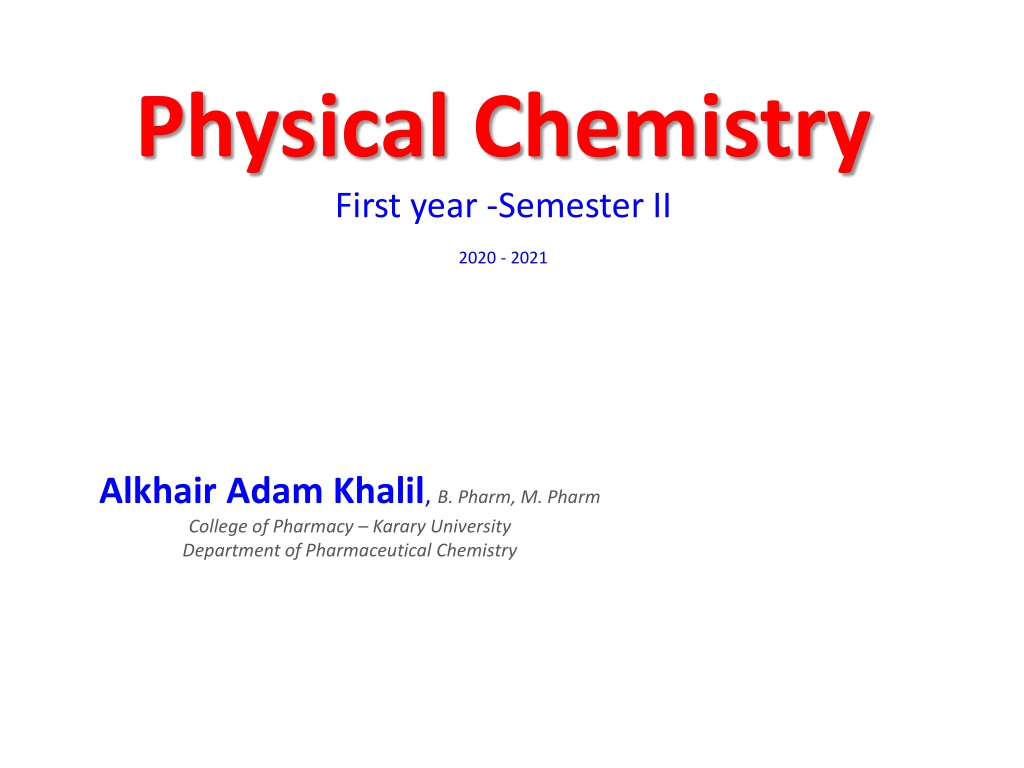Role of Chemistry in Pharmaceutical Sciences
Medicines and drugs used for treating diseases are organic or inorganic chemicals. Studying drug chemistry is essential for pharmacists. This course covers fundamentals of chemistry, states of matter, radiochemistry, thermodynamics, kinetics, and chemical equilibria. Important subtopics include atomic structure, quantum numbers, chemical bonding, and intermolecular forces. References include books by Ira N. Levine, Bahl and Tauli, and Robert G. Mortimer. The discovery of the atom and sub-atomic particles like electrons are also discussed.
Download Presentation

Please find below an Image/Link to download the presentation.
The content on the website is provided AS IS for your information and personal use only. It may not be sold, licensed, or shared on other websites without obtaining consent from the author. Download presentation by click this link. If you encounter any issues during the download, it is possible that the publisher has removed the file from their server.
E N D
Presentation Transcript
Physical Chemistry First year -Semester II 2020 - 2021 Alkhair Adam Khalil, B. Pharm, M. Pharm College of Pharmacy Karary University Department of Pharmaceutical Chemistry
Role of chemistry in pharmaceutical sciences Medicines or drugs that we take for the treatment of various diseases are chemicals, either organic or inorganic. However, most drugs are organic molecules. All drugs are chemicals, and pharmacy is a subject that deals with the study of various aspects of drugs. Therefore, it is needless to say that to become a good pharmacist the knowledge of the chemistry of drugs is essential.
Course contents: 1. Fundamentals of chemistry: Atomic structure and Quantum numbers Electronic configurations Chemical bonding & Hybridization theory (SP3, SP2, SP) Shapes of molecules and ions (VSEPR theory) Inter-molecular forces 2. States of matter and their physicochemical properties 3. Radio-chemistry 4. Fundamentals of Thermodynamics 5. Chemical Kinetics 6. Chemical equilibria
References Physical chemistry by Ira N. Levine Essentials of Physical chemistry by Bahl and Tauli Physical chemistry by RobertG. Mortimer
Sub-atomic particles 3. Sir Joseph John Thomson in 1896 discovered the electron. He also proposed the plum pudding model for an atom
4. In the years that followed, radioactivity was extensively investigated, notably by the husband and wife team of Pierre Curie and Marie Curie. One of the pieces of evidence for the fact that atoms are made of smaller particles.
5. The nucleus was discovered in 1911, as a result of Ernest Rutherford's efforts to test Thomson's "plum pudding model" of the atom.
In 1919, Ernest Rutherford discovered the Proton.
8. James Chadwick discovered the neutron In 1932
Models for atomic nucleus consisting of protons and neutrons explained the puzzle of nuclear spins and the origins of beta radiation in 1934
Quark structure of Nucleons Proton uud Neutron ddu
1 = Object (Element or compound) 2 = Molecules 3 = Atoms 4 = Electrons 5 = Nucleons (Protons + Neutrons) {Baryons} 6 = Quarks 7 = ???????????
Quantum Numbers Three coordinates that come from Schr dinger's wave equations are the principal (n), angular (l), and magnetic (m) quantum numbers. These quantum numbers describe the size, shape, and orientation in space of the orbitals on an atom.
The principal quantum number (n) describes the size of the orbital. The principal quantum number indirectly describes the energy of an orbital. The principal quantum number (n) cannot be zero. The allowed values of n are therefore 1, 2, 3, 4, and so on.
The angular quantum number (l) can be any integer between 0 and n - 1. The angular momentum quantum number (l) is usually designated by a letter (s, p, d, f, etc) If n = 3, for example, l can be either 0, 1, or 2. (s = 0, p =1, d = 2).
The choice of letters originates from a now- obsolete system of categorizing spectral lines as "sharp", "principal", "diffuse" and "fundamental" (or "fine"). After "f", the sequence continues alphabetically "g", "h", "i"... (l = 4, 5, 6...), skipping "j"
The magnetic quantum number (m) can be any integer between -l and +l. If l= 2, m can be either -2, -1, 0, +1, +2.
The only allowed combination of quantum numbers for which n = 1 is the following: n lm 1 0 0 1s
There are four orbitals in the n = 2 shell. nl m 2 0 0 1 -1 0 2p 1 2s
There are nine orbitals in the n = 3 shell. n l m 3 0 0 3s -1 1 0 3p 1 -2 -1 2 0 3d 1 2
Experimental evidence suggests that an orbital can hold no more than two electrons. To distinguish between the two electrons in an orbital, we need a fourth quantum number, This is called the spin quantum number (s). One of the electrons in an orbital is arbitrarily assigned an s quantum number of +1/2, the other is assigned an s quantum number of -1/2.
Questions ! 34
























